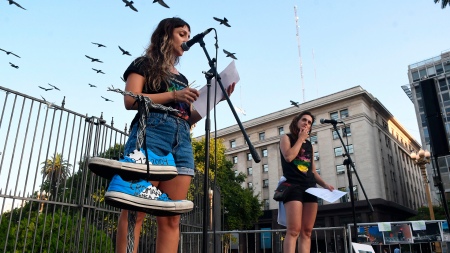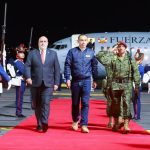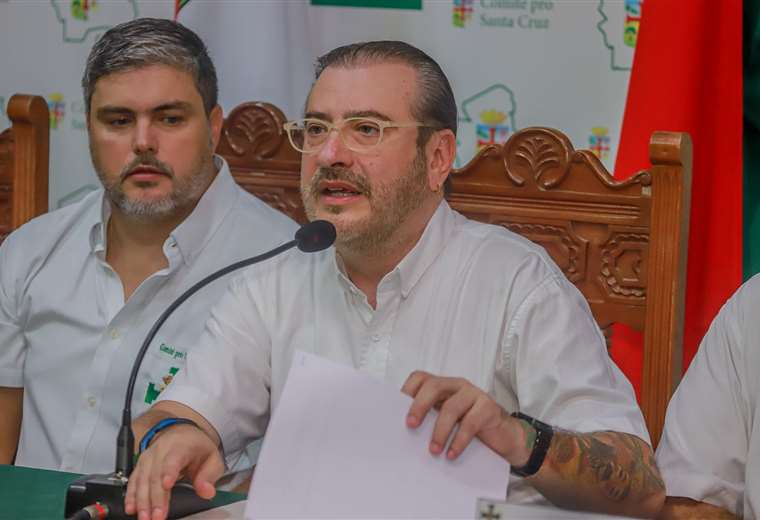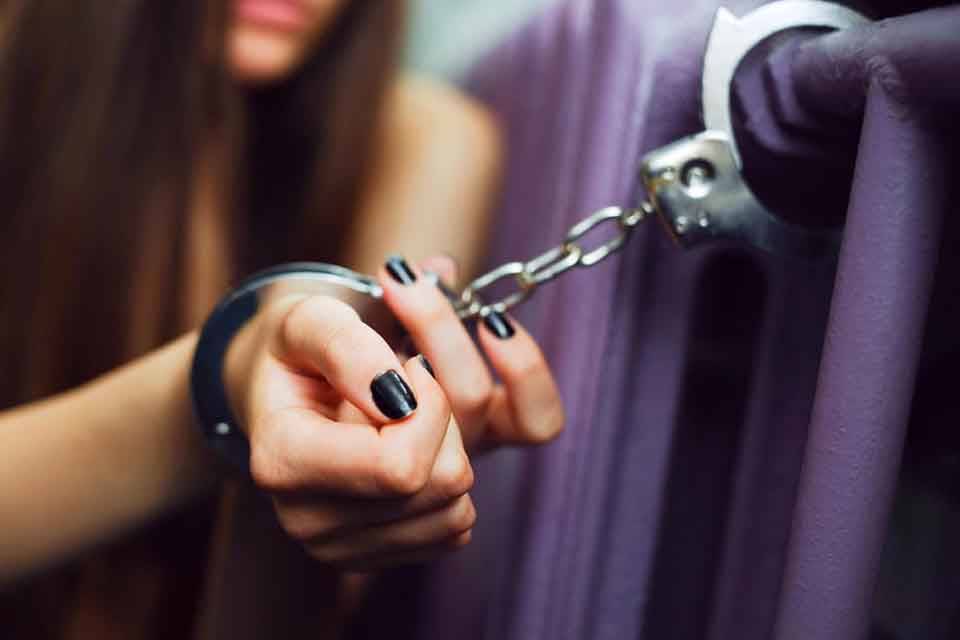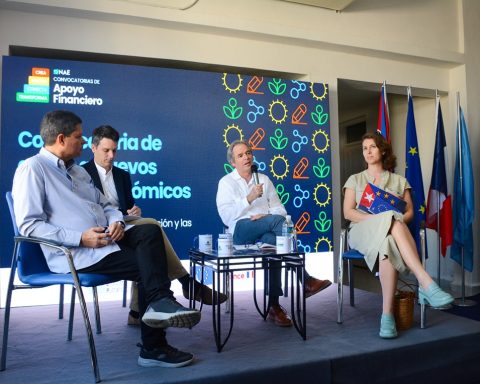The group Hacemos Memoria, which brings together relatives and victims of the Cromañón massacre, considered that “the expropriation law (of the property) had sufficient consensus from the political arc to demonstrate that it is a fact that it crossed us all”on the 18th anniversary of the tragedy, while Pato Fontanet, the former leader of Callejeros, gathered around 1,000 peopleaccording to the organizers, who cheered it on and waved flags with slogans such as “Music does not kill” and “I take the kids forever.”
Thousands of people marched from Plaza de Mayo to the place where the República de Cromañón nightclub was located, in the Once area of Buenos Aires, while a smaller number, who consider the members of Callejeros to be survivors, gathered nearby. of the Obelisk where Fontanet sang for 20 minutes.
the night of horror
The December 30, 2004a flare lit in the recital that the Callejeros band was giving in the República Cromañón bowling alley set fire to the roof of flammable material and the fire broke out in the premises where twice the number of people had entered, added to the impossibility of leaving the place Due to the blocked emergency exit, it caused the death of 194 people and injuries of varying degrees to 1,500 people.

In 2009Justice sentenced the manager of the venue Omar Chabán, the manager of the band Diego Argañaraz, the deputy commissioner Carlos Díaz, the general coordinator of the bowling alley Raúl Villarreal and the officials Fabiana Fiszbin and Ana María Fernández.
In 2011, Casación attenuated the qualifications of intentional fire to culpable -and attributed that same figure to the members of Callejeros-; and non-compliance or omission of the duties of a public official.
On October 27, Congress approved national law 27,695 for the expropriation of the Cromañón premises for the creation of a memory site.
18 years later

In Plaza de Mayo, the activity started at 4:00 p.m. with a discussion table where a document from the relatives and friends of the victims who were members of the Hacemos Memoria group was read.
Meanwhile, the group “Que no nos cuentan Cromañón” read another document in the Obelisk area, where the band Don Osvaldo, Fontanet’s new musical group, performed on a stage set up on Diagonal Norte and Esmeralda.
The march from Plaza de Mayo to the Sanctuary took just over two blocks and they walked led by a gigantic banner of “Los pibes y las pibas de Cromañón”, where the photos of the victims were seen.

Accompanying the resounding of the bass drums, the chant “it was only boys who were murdered that night in Cromañón, who only wanted a recital and found themselves in the gas chamber” could be heard.
“The kids from Cromañón present, the survivors from Cromañón present, now and always”, could be heard when the clapping and the sound of the drums ceased.
T-shirts with the legend that said “Cro-Magnon space for memory”, “12-30-04 justice”, “Enough of impunity”, “Cro-Magnon happened to us all” or “Enough of young death” were seen on many young people.
The photos of the victims of Cromañón were also present on the chests of relatives who had them printed on their T-shirts or through posters.
“Listen to a flare or rock and roll, our kids are killed by corruption,” sang the relatives, survivors, and friends of the victims.
Upon reaching the corner where the bowling alley was located, now covered with plates, inscriptions and posters with the legend “Cro-Magnon, Space for Memory”, relatives began to beat them in a climate of great emotion.
Then they toured the sanctuary, where the objects carried by the victims at the time of the massacre are observed, along with artistic works and murals, while at 10:40 p.m. they released balloons.
Earlier, at a table held at 4:00 p.m., in the Plaza de Mayo, Diego Zenobi, the moderator of “Experiences with Spaces of Memory”, highlighted the “possibility of building memory and promoting some reparation” that the State offered by expropriating the site where the Cromañón massacre occurred.
“The fact that the State and politics have promoted the expropriation and the creation of a memory space is not only something that promotes a certain reparation, but also gives the possibility of telling the story, building memory and continuing to reread what happened since the perspective of those affected themselves,” he told Télam Zenobi.
The Hacemos Memoria document stressed that “we have the law” when referring to expropriation.

“But now we need that this law be complied with, that it not remain a dead letter like so many laws that Congress approves and are later broken. That is why we ask the President of the Nation, Alberto Fernández, to arbitrate the media for the effective takeover of Cromañón, as well as the regulation of the law”, they explained.
Already on the march, Silvia Bignami, the mother of Julián Rozengardt, who died at the age of 18, warned Télam that “the word Cro-Magnon means something very terrible. It is the day that Julián was no longer there, but it also means everything that is wrong, what doesn’t work, what is tied with a wire, corruption. All that means Cro-Magnon”.
“Cromañón represents everything that does not have to be repeated, that no one has to go through again. For us it was very painful, very crude, for those reasons we are here and we are fighting so that it does not happen again,” said Belkys I continue, a survivor of the massacre.
And he continued: “Cromañón was the responsibility of adults. Private sectors in complicity with the State allowed the systematic death of 194 boys and girls. That is why we ask for reparation, not only to the victims but to all of society.”
Fontanet on the Obelisk
While this was happening in Plaza de Mayo, Patrick “Duck” Fontanetformer leader of Callejeros when the Cromañón massacre occurred, gave a recital at the Obelisk, where his supporters gathered under the slogan on networks “don’t tell us about Cromañón.”

Fontanet, who now leads the Don Osvaldo group, was cheered upon entering the stage set up in the Plaza de la República, where hundreds of people began to wave flags with phrases alluding to the massacre.
Among them were read “Music does not kill” and “I take the kids forever.” Most of the flags came from towns in the Buenos Aires suburbs.
Fontanet sang for about 20 minutes without alluding to the massacre and after introducing himself with the song “Normal”, he then sang “Ciegos”, “O No”, “Más Allá”, “Dos Secas”, which were sung furiously by the public present.
After 20 minutes, Fontanet concluded the recital, while the audience chanted “corruption killed these kids” and “Callejeros is a feeling I can’t stop”.
Also here, relatives read a document.
“We ended 2021 with Pato, Dios and the musicians from Don Osvaldo on this stage, recovering a space that should always have belonged to them and that for many years was closed to them,” they said.

“Our work and that of other organizations of relatives and survivors achieved a historic milestone, which marks a break in the midst of our struggle to keep Memory alive and the claim for Truth and Justice. This year we recovered Cromañón!”, they added in the agreed text.
“In a short time, Cromañón will be ours. Of those who were there, those who were our age, but were not there, those who came back and even those who were not born, among the that our children, nephews, sisters and relatives are there,” they warned.
Then they recalled that some of their “companions were very young and very oblivious to everything that was happening. The power of memory, the active struggle that we raised, sustained and militated all these years allowed them to approach this space of struggle and collective memory”.
And they concluded: “Cro-Magnon, now it belongs to everyone. We earned the right to tell that story, it is a minimum payment for so much pain, tears and spilled fight.”
